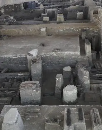Yancheng Lacquer Screen Photogrammetry Study Reveals Insights into Ancient Medical Practices

In a groundbreaking discovery in Yancheng, Jiangsu Province, Chinese archaeologists have unveiled an intricately designed lacquer screen that offers new insights into ancient medical practices. This stunning artifact dates back to the Han Dynasty (202 BCE–220 CE), a period renowned for its advancements in various fields, including medicine.
Photogrammetry, a technique widely used in modern archaeology, has been employed by researchers at Sun Yat-sen University (SYSU) in Guangzhou to meticulously document and analyze the screen's intricate details. By combining multiple two-dimensional images into detailed three-dimensional models, the team was able to uncover features of the lacquer screen that were previously undetectable with the naked eye.
One of the most significant findings is the depiction of ancient medical practices on the screen. Among the many scenes illustrated on the lacquer surface, a segment shows what appears to be early surgical procedures. These depictions include the use of tools that resemble those found in ancient medical texts, suggesting that these techniques may have been used to treat soldiers wounded in battles or common folk suffering from diseases.
The lead archaeologist on the project, Dr. Wang Lei, emphasized the importance of this discovery: "The level of detail and precision in these illustrations is remarkable. They provide us with invaluable information about the medical knowledge and techniques employed during this era." Learn more about SYSU.
Further analysis of the screen is ongoing, and the research team hopes to publish their complete findings soon. The discovery in Yancheng has already sparked interest among historians and scholars around the world, and it is expected to contribute significantly to our understanding of ancient Chinese medical practices.
 LongStory.Asia The Digital Archaeological Portal
LongStory.Asia The Digital Archaeological Portal